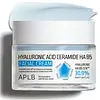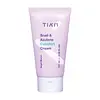What's inside
What's inside
 Key Ingredients
Key Ingredients

 Benefits
Benefits

 Concerns
Concerns

 Ingredients Side-by-side
Ingredients Side-by-side

Water
Skin ConditioningCentella Asiatica Extract 30.4%
CleansingGlycerin
HumectantCetyl Ethylhexanoate
EmollientButylene Glycol
HumectantPolyglyceryl-3 Methylglucose Distearate
EmulsifyingPanthenol
Skin ConditioningSodium Hyaluronate
HumectantCeramide NP
Skin ConditioningStearic Acid
CleansingSodium Polyacryloyldimethyl Taurate
Emulsion StabilisingHydrogenated Polydecene
EmollientTrideceth-10
CleansingSilica
AbrasiveGlyceryl Stearate
EmollientBeeswax
Emulsion StabilisingButyrospermum Parkii Butter
Skin ConditioningMacadamia Ternifolia Seed Oil
EmollientBetaine
HumectantTrehalose
HumectantCitric Acid
BufferingSodium Citrate
BufferingNelumbo Nucifera Extract
Skin ConditioningArtemisia Annua Extract
MaskingOryza Sativa Extract
AbsorbentSaccharomyces Ferment
Skin ConditioningSolanum Melongena Fruit Extract
Skin ConditioningMelaleuca Alternifolia Leaf Extract
PerfumingHydrolyzed Collagen
EmollientSqualane
EmollientBeta-Glucan
Skin ConditioningDipropylene Glycol
HumectantHippophae Rhamnoides Fruit Extract
Skin ConditioningMadecassic Acid
Skin ConditioningAsiaticoside
AntioxidantAsiatic Acid
Skin ConditioningOctyldodecanol
EmollientHydrogenated Lecithin
EmulsifyingPhytosteryl/Octyldodecyl Lauroyl Glutamate
Skin ConditioningMelia Azadirachta Leaf Extract
Skin ConditioningMelia Azadirachta Flower Extract
Skin ConditioningCoccinia Indica Fruit Extract
Skin ConditioningOcimum Sanctum Leaf Extract
Skin ConditioningCurcuma Longa Root Extract
MaskingCorallina Officinalis Extract
Skin ConditioningDisodium EDTA
Propanediol
SolventHydroxyacetophenone
Antioxidant1,2-Hexanediol
Skin ConditioningEthylhexylglycerin
Skin ConditioningDipotassium Glycyrrhizate
HumectantWater, Centella Asiatica Extract 30.4%, Glycerin, Cetyl Ethylhexanoate, Butylene Glycol, Polyglyceryl-3 Methylglucose Distearate, Panthenol, Sodium Hyaluronate, Ceramide NP, Stearic Acid, Sodium Polyacryloyldimethyl Taurate, Hydrogenated Polydecene, Trideceth-10, Silica, Glyceryl Stearate, Beeswax, Butyrospermum Parkii Butter, Macadamia Ternifolia Seed Oil, Betaine, Trehalose, Citric Acid, Sodium Citrate, Nelumbo Nucifera Extract, Artemisia Annua Extract, Oryza Sativa Extract, Saccharomyces Ferment, Solanum Melongena Fruit Extract, Melaleuca Alternifolia Leaf Extract, Hydrolyzed Collagen, Squalane, Beta-Glucan, Dipropylene Glycol, Hippophae Rhamnoides Fruit Extract, Madecassic Acid, Asiaticoside, Asiatic Acid, Octyldodecanol, Hydrogenated Lecithin, Phytosteryl/Octyldodecyl Lauroyl Glutamate, Melia Azadirachta Leaf Extract, Melia Azadirachta Flower Extract, Coccinia Indica Fruit Extract, Ocimum Sanctum Leaf Extract, Curcuma Longa Root Extract, Corallina Officinalis Extract, Disodium EDTA, Propanediol, Hydroxyacetophenone, 1,2-Hexanediol, Ethylhexylglycerin, Dipotassium Glycyrrhizate
Snail Secretion Filtrate 92%
Skin ConditioningCetearyl Olivate
Sorbitan Olivate
EmulsifyingCaprylic/Capric Triglyceride
MaskingButylene Glycol
HumectantCetearyl Alcohol
EmollientBetaine
HumectantDimethicone
EmollientCarbomer
Emulsion StabilisingEthyl Hexanediol
SolventPhenoxyethanol
PreservativeAllantoin
Skin ConditioningArginine
MaskingSodium Polyacrylate
AbsorbentSodium Hyaluronate
HumectantPanthenol
Skin ConditioningXanthan Gum
EmulsifyingAdenosine
Skin ConditioningPalmitic Acid
EmollientStearic Acid
CleansingWater
Skin ConditioningSodium Guaiazulene Sulfonate
Snail Secretion Filtrate 92%, Cetearyl Olivate, Sorbitan Olivate, Caprylic/Capric Triglyceride, Butylene Glycol, Cetearyl Alcohol, Betaine, Dimethicone, Carbomer, Ethyl Hexanediol, Phenoxyethanol, Allantoin, Arginine, Sodium Polyacrylate, Sodium Hyaluronate, Panthenol, Xanthan Gum, Adenosine, Palmitic Acid, Stearic Acid, Water, Sodium Guaiazulene Sulfonate
Ingredients Explained
These ingredients are found in both products.
Ingredients higher up in an ingredient list are typically present in a larger amount.
Betaine is a common humectant (a substance that promotes retention of moisture). It's known to be gentle on the skin and can help balance hydration.
This ingredient is best for improving hydration and soothing irritated skin. Studies also show it helps even out skin tone.
Fun fact: Betaine is naturally created in the skin and body. The kind found within cosmetic products can be either plant-derived or synthetic.
Another name for betaine is trimethylglycine.
Learn more about BetaineButylene Glycol (or BG) is used within cosmetic products for a few different reasons:
Overall, Butylene Glycol is a safe and well-rounded ingredient that works well with other ingredients.
Though this ingredient works well with most skin types, some people with sensitive skin may experience a reaction such as allergic rashes, closed comedones, or itchiness.
Learn more about Butylene GlycolPanthenol is a common ingredient that helps hydrate and soothe the skin. It is found naturally in our skin and hair.
There are two forms of panthenol: D and L.
D-panthenol is also known as dexpanthenol. Most cosmetics use dexpanthenol or a mixture of D and L-panthenol.
Panthenol is famous due to its ability to go deeper into the skin's layers. Using this ingredient has numerous pros (and no cons):
Like hyaluronic acid, panthenol is a humectant. Humectants are able to bind and hold large amounts of water to keep skin hydrated.
This ingredient works well for wound healing. It works by increasing tissue in the wound and helps close open wounds.
Once oxidized, panthenol converts to pantothenic acid. Panthothenic acid is found in all living cells.
This ingredient is also referred to as pro-vitamin B5.
Learn more about PanthenolSodium Hyaluronate is hyaluronic acid's salt form. It is commonly derived from the sodium salt of hyaluronic acid.
Like hyaluronic acid, it is great at holding water and acts as a humectant. This makes it a great skin hydrating ingredient.
Sodium Hyaluronate is naturally occurring in our bodies and is mostly found in eye fluid and joints.
These are some other common types of Hyaluronic Acid:
Learn more about Sodium HyaluronateStearic Acid is a fatty acid. It is an emollient, emulsifier, and texture enhancer.
As an emollient, stearic acid helps soften skin. It aids the skin's protective barrier by preventing water loss. It also provides a gentle cleansing effect without stripping away natural oils.
Stearic acid may also be used to enhance the texture of products. It can add volume and stabilize ingredients such as water and oil. This can help water and oil ingredients from separating.
Sources of stearic acid include animal or vegetable fats/oils such as coconut or shea. It can be naturally found in butter, cocoa butter, shea butter, vegetable fats, and animal tallow.
This ingredient may not be Malassezia folliculitis, or fungal-acne safe.
Learn more about Stearic AcidWater. It's the most common cosmetic ingredient of all. You'll usually see it at the top of ingredient lists, meaning that it makes up the largest part of the product.
So why is it so popular? Water most often acts as a solvent - this means that it helps dissolve other ingredients into the formulation.
You'll also recognize water as that liquid we all need to stay alive. If you see this, drink a glass of water. Stay hydrated!
Learn more about Water